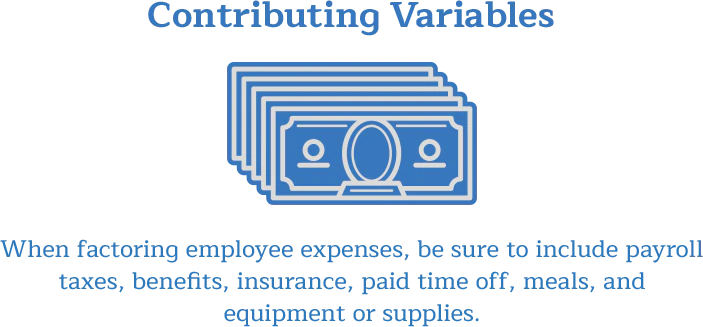How to determine the true cost of an hourly employee
2019 fully-loaded employee cost calculators*
Please fill in the blue boxes
How much does an employee cost?
Each employee costs the sum of his or her gross wages. This is in addition to other employee-related expenses, including state payroll taxes, Social Security and Medicaid taxes, and the cost of benefits (insurance, paid time off, and meals or equipment or supplies).
How to calculate labor cost per hour
Calculate an employee’s labor cost per hour by adding their gross wages to the total cost of related expenses (including annual payroll taxes and annual overhead), then dividing by the number of hours the employee works each year. This will help determine how much an employee costs their employer per hour. It is important to have a consistent employee timesheet software or app for long term labor cost success.
Here’s a labor cost example: Let’s say an employee is paid $15 per hour. If they work 40 hours per week for 52 weeks, they will work 2,080 hours, which makes their labor cost $31,200 (pre-tax) per year. But if that employee is absent from work for 15 days that year (taking paid time off), they will actually work closer to 1,960 hours per year — making their actual hourly rate closer to $16.
Sticking with that $31,200, we can now use the labor cost formula to determine the amount of annual overhead costs an employer pays in addition to that employee’s hourly wage. This includes building costs, property taxes, utilities, payroll taxes, benefits, insurance, supplies, and equipment costs. Once the total overhead is added together, divide it by the number of employees, and add that figure to the employee’s annual labor cost.
In this case, the employee’s annual labor cost is $31,200. But let’s say an employer spends an additional $8,000 on that employee throughout the year. Add $8,000 and $31,200 to get $39,200. Now, divide $39,200 by the number of hours the employee will actually work in a year (about 1,960) to calculate the true hourly rate of that employee. In this example, the total hourly cost of that employee is closer to $20 per hour.

How to calculate the labor cost formula
The labor cost formula takes into account an employee’s hourly wages, the hours they work in a week, and the weeks they work in a year. An employer’s overhead cost per employee is also considered, in addition to the employer’s annual taxes. Each cost is added together and then divided by the employee’s hours worked per year. It’s vital that an employer has a time tracking solution in this case.
What is the cost of labor?
The cost of labor is the sum of each employee’s gross wages, in addition to all other expenses paid per employee. Other expenses include payroll taxes, benefits, insurance, paid time off, meals, and equipment or supplies.
How to calculate true overhead rates
Knowing the true cost of an employee is one thing, but if you’re not including the cost of overhead in your equation, you could be under-billing your clients and losing money! Knowing how to accurately calculate the cost of overhead for each employee will help you determine what to charge and how to remain profitable.
Start by determining the true cost of your employees. Not sure how to do this? Use the calculator above. Then calculate your overhead.
What is overhead?
Overhead represents the average cost of benefits per employee. These include all the expenses you pay outside of labor costs — things like building costs, property taxes, and utilities — and they can be calculated either monthly or annually, depending on the needs of your business. To figure it out, just divide your total annual overhead costs by the number of employees at your business.

Want to determine your employee’s billable rate? Take the true cost of your employee per hour (including employee labor costs, overhead, and taxes) and add it to your profit margin. Then divide this number by the number of hours your employee works per year, and you’ve got your billable rate. No more lost profits!
What are payroll taxes?
As a business owner, you’re required to pay taxes for the Federal Insurance Contributions Act (FICA), which covers Social Security and Medicare, and the Federal Unemployment Tax Act (FUTA), which funds workforce agencies. On top of that, there are unemployment taxes, which vary by state but can include state income taxes and unemployment insurance.
State taxes aside, navigating federal payroll taxes can feel a bit like navigating a minefield. One wrong step and – boom! you’re in trouble with the IRS. It’s always a best practice to check with your accountant when it comes to calculating payroll taxes (or anything to do with numbers), but you can get a pretty accurate estimate by following these steps.
The Federal Unemployment Tax Act (FUTA) sets your unemployment tax rate per employee at 6 percent, but if you qualify, you can claim a 5.4 percent credit. That would make your FUTA tax rate .6 percent. However, once an employee’s year-to-date earnings surpass $7,000, you no longer have to pay the FUTA federal unemployment tax on that employee for the remainder of the year.
1. What is your federal unemployment (FUTA) tax rate?
While you should always check with your accountant to know where you stand, businesses that file the Form 940, or the Employer’s Annual Federal Unemployment (FUTA) Tax Return, typically qualify for the 5.4 percent credit. If you pay wages of $1,500 or more to your employee in any calendar quarter, or if you oversee one or more employees (part-time, full-time, and temporary) at least some part of a day in 20 or more weeks per year, you must file Form 940.
For more information, see the IRS FUTA Credit Reduction Guide
2. What is your Social Security (FICA) tax rate?
Social Security tax is 6.2 percent of the taxable wages paid to each employee each year (up to $127,200 for 2017, a number that changes annually).
3. What is your Medicare (FICA) tax rate?
Medicare tax is 1.45 percent of all taxable wages paid to each employee, with an additional .9 percent tax rate on wages that exceed $200,000.
4. What is your state’s unemployment tax rate?
This rate (and the annual wage limit) is determined for you by your state unemployment agency. Some state unemployment tax rate minimums are as low as 0.0%, as is the case in places like Hawaii, Iowa, Mississippi, Missouri, Montana, Nebraska, and South Dakota. Meanwhile, maximum tax rates can be as high as 12 percent, as is the case in Wisconsin. Always check with your accountant if you’re not sure where you stand.
5. What is your employment or job-training tax rate?
Some states require employers to pay employment or job-training taxes. If you’re not sure whether or not your state is one of them, check with your accountant.
Labor cost FAQ
Additional resources
- Choosing a payroll provider for the first time? Here’s how to choose a payroll service provider.
- Need a QuickBooks and payroll expert? Check out our ProAdvisor Accountant Directory.
- Learn more about federal unemployment tax rates from the IRS.
- Learn more about state unemployment tax rates from the Tax Policy Center.
- Read more about the Affordable Care Act “Obamacare” coverage and cost requirements.
- Read more about employer costs for employee compensation from the Bureau of Labor.
- Need to know how much an employee costs in California? Read all about California overtime laws.